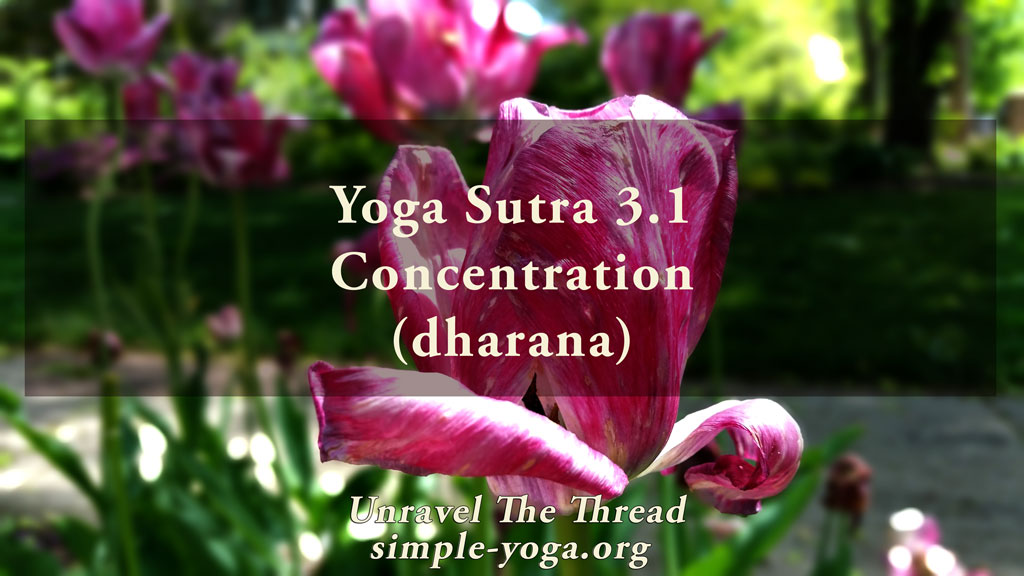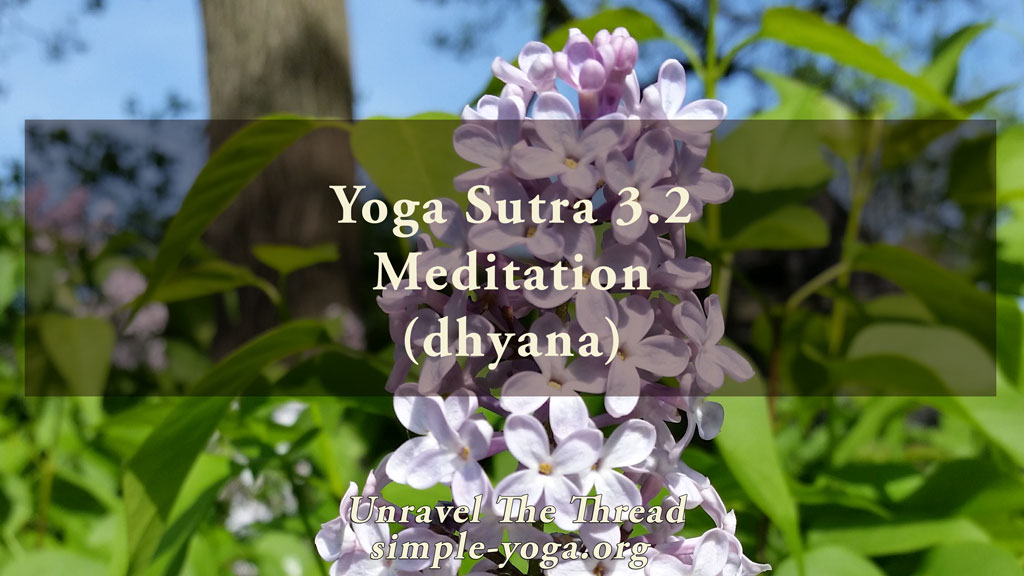
3.1 Concentration – dharana
May 30, 2021
3.3 Samadhi – integration
June 12, 2021
3.1 Concentration – dharana
May 30, 2021
3.3 Samadhi – integration
June 12, 20213.2 Meditation – dhyana

3.2 Meditation (dhyana) is to maintain the focus effortlessly.
Meditation is the natural progression resulting from concentration. Once again, the suggestion of complementing doing with letting go (being) appears in this aphorism. Concentration is a doing, inviting your attention to stay on a single point. As you remain in concentration, you gradually ease the amount of effort to staying focused so that you progressively let go of all tension and unnecessary doing to remain present without wasting any physical, mental, or emotional energy (being). It is like riding a bicycle. At the beginning, staying on your bike requires a lot of your energy and attentional resources. The more adept you become at riding, the more efficient the process becomes. At some point it may be possible to use the minimum amount of energy to hold the handlebars to determine your course with great ease. It may even happen that eventually you can let go of the handlebars and continue to ride your bike, changing direction by just shifting your body weight. Meditation is like any other skill; it improves through deliberate practice. Expectations may be the most frequent source of frustration in meditation, and in life. Some expectations include not getting distracted at all or being able to empty your mind completely. In addition, common accounts of extraordinary experiences or insight are often a hindrance rather than a catalyst for meditation. For instance, if you read that advanced meditators see lights akin to fireworks or feel this or that, you may expect to have those experiences, or you may try to emulate them. When your meditation practice does not produce the expected results, you will likely feel disappointed in yourself, maybe even coming to think that there must be something wrong with you because you cannot see the purple iridescent light you read about in some book, or when you cannot levitate as it says in some other text. Meditation is the highest of yogic practices especially when seen as just being with what is as it is and with yourself just as you are. Developing this attitude is very useful for all of yoga and very practical in all aspects of life.
Beware of any inclination to generate more opinions, comments, and preferences to what you are experiencing, as this is often an easy way to get entangled in your own stories. It is more productive to practice detaching (vairagya) and releasing physical, mental, and emotional gripping in order to sense with diminishing reactivity. In other words, you keep honing the skill of tuning in, feeling, and witnessing the richness of your inner universe. Remembering that your inner life is ineffable can assist you in releasing your tendencies to add labels, opinions, and explanations to what can only be experienced directly.
One of the traditional meditation techniques is called japa, which means muttering, whispering, or repeating a prayer, passages from sacred texts, or the name of a deity. In sutras 1.27 and 1.28, one way of practicing japa was introduced when talking about the syllable OM (ॐ) as a key to align with Supreme Being. One way of practicing japa with OM, or with any other meditational mantra, such as the seed (bija) sounds lam, vam, ram, yam, ham and ksham, is to start chanting aloud and gradually decreasing the volume of the sound so that the chant eventually becomes a whisper that finally turns into an internal silent chant. Even after the chant is silent it may be possible to change the level of intensity of the silent chant to make it increasingly subtler. Attention remains focused on the subtlest version of the chant until it may be possible to have the faintest connection to the silent whispering within. When the chant becomes an effortless echo it is called ajapa japa. At this level of practice, the goal is to maintain that subtle unconscious repetition. However, when distractions emerge, it may be necessary to return to a louder silent chant or to audible chanting to re-focus. As usual, noticing your distractedness indicates that you are growing in your capacity to recognize how some of your ways of being pull you away from presence. Just return to the subtlest version of chanting possible gently letting go of all unnecessary effort. Remember that staying with any practice can be facilitated by telling yourself I want to do this, I need to do this, I can do this, and I will do this. As expectations arise, recognize that it is important not to confuse the practice with the resulting experience (sensations, thoughts, emotions). With patient persistence keep returning effortlessly to your focal point, as many times as you need to.
What happens when you try to practice meditation?
What do you notice?
What are the sources of distraction?
How do you feel?
As usual, one more way of exploring the meaning of this sutra is by chanting it.
You can choose to chant it in its traditional form with some of the words coming together:
तत्र प्रत्ययैकतानता ध्यानम् ॥२॥
tatra pratyayaikatānatā dhyānam ॥2॥
Another option is to chant each word in the sutra individually:
- tatra
- pratyaya
- ekatānatā
- dhyānam
If you prefer, you may listen to the podcast:
Unravel the thread is now available as a book!
If you find Simple-Yoga.org and Unravel the thread useful, consider supporting my labor with a donation, you may also donate using PayPal or Venmo. Thank you!
